Samsung QE55Q70R Review
Samsung QE55Q70R Review
This excellent 4K TV delivers a QLED experience for those on a budget
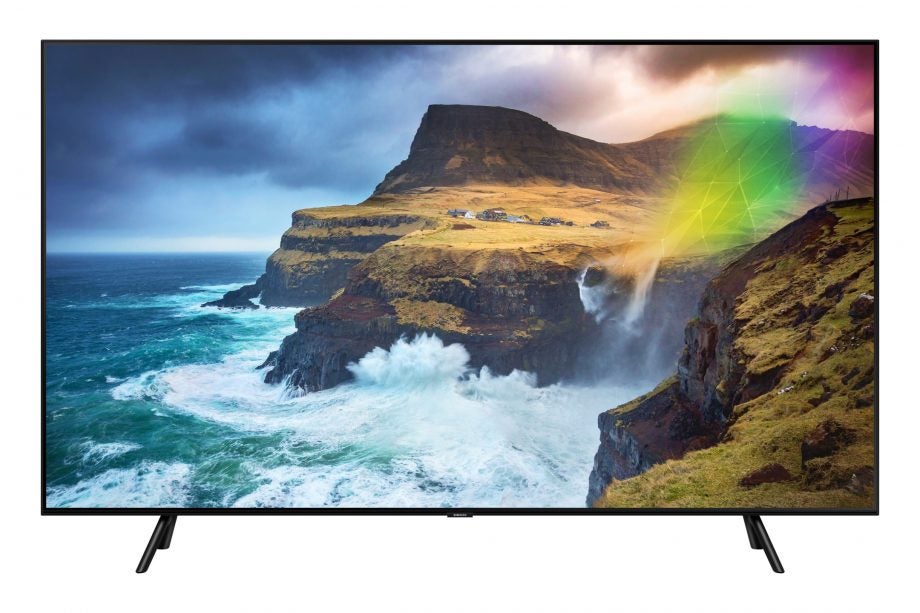
Verdict
This mid-range 4K TV is a cost-effective way of getting into QLED, with a direct backlight and local dimming. A few corners have been cut to get the price down, but this doesn’t impact on the excellent SDR and HDR performance, plus the smart system remains comprehensive. Only a lack of support for Dolby Vision disappoints.
Pros
- Great picture quality
- Good HDR performance
- Comprehensive smart platform
- Incredibly low input lag
Cons
- No Dolby Vision or Atmos support
- Limited viewing angles
Key Specifications
- Review Price: £1399
- Ultra HD resolution
- HDR: HDR10, HLG, and HDR10+
- Tizen OS with Bixby
- 4 x HDMI 2.0b
The Samsung Q70R (QE55Q70R) is the latest mid-range 4K TV from the manufacturer, and it represents the cheapest way of buying a 2019 QLED model with a direct backlight and local dimming. Sadly, in order to keep down the cost the ultra-wide viewing angles and black filter found on the more expensive models are lacking, and you don’t get a One Connect box, either.
However, you still get the excellent AI-enhanced processing, adaptive sound features, and comprehensive smart system. Thanks to a recent price drop it’s also competitively positioned, providing an opportunity to pick up many of the performance features of a 2019 QLED without paying a premium.
The Q70R is available in five screen sizes: QE49Q70R (£1199); QE55Q70R (£1399) reviewed here; QE65Q70R (£1999); QE75Q70R (£3499); and QE82Q70R (£4799).
Related: Best TVs
Samsung QE55Q70R design − is fairly basic in terms of look, which reflects its lower price
The Samsung QE55Q70R uses a design that’s fairly basic in terms of its styling when compared to the more expensive entries in the 2019 QLED range. This clearly reflects the Q70’s lower price point, but it still uses Samsung’s 360-degree design ethos with a virtually bezel-less screen, a black border around the outer edge, and textured grooves at the rear.
Related: Samsung TV 2019 – every new Samsung 4K QLED TV explained

The panel sits on a pair of feet that simply slot into place without the need for screws, providing solid support. However, those feet are set quite far apart, which means you’ll need a fairly wide surface on which to place the TV. Of course, if this is an issue then you could always opt to wall-mount the panel instead.
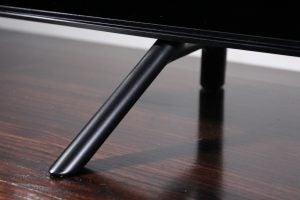
Unfortunately, the Q70 lacks Samsung’s clever One Connect box. Instead, all the connections are located on the rear of the panel. At least the inputs are the same: four HDMI (one with ARC), three USB, twin terrestrial and satellite tuners, CI slot, optical digital input, AutoCal connector, and LAN port for a wired connection (along with built-in Wi-Fi and Apple AirPlay 2).
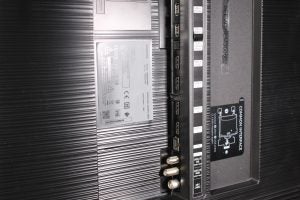
Unlike LG’s 2019 TVs, Samsung’s QLED range doesn’t use HDMI 2.1, instead sticking with HDMI 2.0b. However, the company claims its TVs can still support 4K at up to 120Hz, dynamic metadata (HDR10+), variable refresh rate (VRR), and auto low-latency mode (ALLM). Samsung’s TVs don’t currently include an enhanced audio return channel (eARC), but it could be added at a later point.
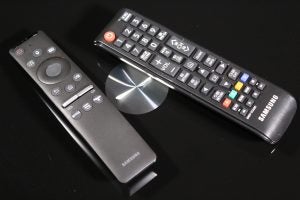
The Q70 comes with two controllers: a fully specced remote and a more basic zapper designed for day-to-day use. The latter might lack the all-metal construction of the wand included higher up the range, but it remains comfortable to hold and easy to use one-handed. It includes a built-in mic for voice control, along with direct access buttons for Netflix, Amazon and Rakuten.
Related: Best cheap TVs
Samsung QE55Q70R features – includes features seen on higher-spec QLEDs, but ultra-wide viewing angle is omitted
The Samsung QE55Q70R uses the same 4K Ultra HD (3840 x 2160) 10-bit VA panel as the higher end QLED models, and it has a 120Hz refresh rate. One of the Q70’s big selling points is a direct backlight combined with a local dimming system that uses around 50 zones based on our calculations.
The Q70 also supports high dynamic range, specifically HDR10, broadcast HLG, and HDR10+. It can deliver 100% of the DCI-P3 wider colour gamut, and in testing it produced a peak brightness of 800 nits on a 10% window.
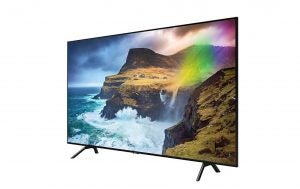
However, Samsung doesn’t support Dolby Vision, and this puts its TVs at a disadvantage to competing models from Panasonic and Philips, which support both forms of HDR with dynamic metadata.
The Q70 also includes Samsung’s Quantum Processor 4K, which means you get the same AI-enhanced processing found on the higher-end models. What you don’t get are the ultra-wide viewing angles and black filter found further up the line.
Related: What is HDR?
Samsung QE55Q70R smart platform – a comprehensive selection of streaming services, including Apple TV
The Samsung QE55Q70R might be cheaper than the higher-end QLED models, but it boasts an identical smart platform that’s based around the Tizen-powered operating system. As a result you get the same launcher bar along the bottom, and a useful second layer that provides quick and easy access to additional content.
Since the main reason for owning a TV is to watch video content, Samsung wins major brownie points for offering the most comprehensive selection of streaming services available. There are apps for Netflix, Amazon, Now TV, Rakuten, YouTube, all the UK TV catch-up services and (thanks to a recent firmware update) Apple TV, which is currently exclusive to Samsung.
Related: Apple TV app and AirPlay 2 now available on Samsung TVs

The Apple TV app works well and is easy to setup and connect with your existing Apple account, providing access to TV shows and movies, as well as your own library. The picture and sound quality are excellent, and the app supports 4K and HDR10. Apple also supports Dolby Vision and Atmos, but Samsung doesn’t support the former and there’s currently no support for the latter, although that could be added.
The Universal Guide is a new feature designed to analyse the bewildering array of content available these days, and to collate all your favourite games, movies, sports, and streaming services into a single user-friendly interface. The guide then uses AI wizardry to monitor your viewing habits, creating a single “For You” page with content tailored to suit your particular tastes.
The Q70 is a piece of cake to install thanks to Samsung’s SmartThings app, allowing you to quickly and easily set-up your TV using your smartphone (it’s available for both iOS and Android). SmartThings also allows you to use your TV as a smart hub, enabling you to sync, share, and control other connected devices in your home.

This year, Samsung has added Bixby as a built-in feature, making interaction largely seamless. Bixby is best accessed by simply pressing the microphone button on the remote, but there’s a near-field mic built into the TV as well. Samsung’s QLED TVs are also compatible with Amazon Alexa, Google Assistant and, thanks to the inclusion of Apple’s AirPlay 2, even Siri.
The Q70 also includes Samsung’s clever Ambient mode, which allows you to utilise your TV, even when you’re not watching it. This feature is energy efficient, and displays information such as the news or the weather, or even artwork and family photos. It can also blend in with the surroundings, making the TV virtually invisible when wall mounted.
Related: Best streaming sites
Samsung QE55Q70R picture quality – an impressive performer that delivers bright and punchy images
The Samsung QE55Q70R proved an impressive performer in general, delivering detailed pictures with plenty of pop. QLED’s strength lies in its ability to deliver bright images boosted by saturated colours, and the Q70 is no exception. The direct backlight ensures that when it comes to SDR and HDR content the TV is able to deliver bright and punchy pictures, while the quantum dots render more accurate colours.
The combination of a direct backlight and local dimming ensures deep blacks, but also well-detailed shadows. In SDR, the incidences of blooming or haloing are minimal, even with bright white objects against a black background, and there’s no visible clipping. The highlights are rendered with remarkable precision because, despite having only 50 zones, Samsung’s local dimming algorithm is one of the best.
Screen uniformity is also good, and despite the lack of the ultra-black filter, reflections are minimal – just don’t put the TV opposite a window. The Q70 uses a VA panel but doesn’t include the ultra-wide viewing angle technology, which means that while the native blacks are excellent for an LCD panel, the optimal viewing angles are fairly narrow.
The AI-enhanced image processing benefits from machine learning that makes full use of all the pixels in the 4K panel when upscaling lower-resolution content. The noise reduction and sharpening is also expertly applied, to ensure compressed material looks as good as possible. As a result, a good-quality source often looks 4K even when it isn’t.
Related: OLED vs QLED – television technology’s battle royale
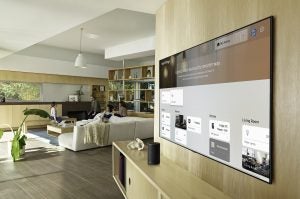
The motion handling is also good for an LCD TV, without resorting to frame interpolation. However, if necessary, the motion settings smooth things out, often proving useful with sporting action where there’s plenty of movement. We measured the input lag at 14ms, which is great news for gamers, especially since there’s no danger of image retention or screen burn.
The Q70 really came into its own with 4K HDR content, and thanks to the effective local dimming the blacks remained deep and inky, while the whites appeared free of clipping. Unlike SDR content, the limited number of dimmable zones is more apparent with HDR, resulting in blooming with more challenging content such as the arrival into lunar orbit in First Man.
A show such as Jessica Jones on Netflix reveals nuanced colours, great shadows and some nice highlights. The same goes for The Grand Tour on Amazon, which also benefits from HDR10+ dynamic metadata. An Ultra HD Blu-ray such as Aquaman is bursting with comic book primaries, while the HDR10+ encoding on the Robin Hood 4K disc means you won’t miss any of the action
Unfortunately, Samsung still doesn’t support Dolby Vision, a proprietary version of HDR that also uses dynamic metadata. This puts the company’s entire TV range (including the Q70) at a disadvantage to models from Panasonic and Philips, both of which support Dolby Vision and HDR10+. However, overall the Samsung Q70 delivers an excellent all-round performance.
Related: Best TV deals
Samsung QE55Q70R audio quality – delivers reasonably good sound for a flatscreen TV
The Samsung QE55Q70R has a 2.1-channel audio system, powered by 40W of amplification. Overall, it sounds reasonably good, primarily because its deeper chassis provides more room for larger speakers. Despite being downward-firing in orientation, they manage to provide a good sense of stereo separation. They also deliver a solid mid-range, and some well-defined treble. However, the bass response is understandably rather limited.
Samsung has improved the sound quality of its TVs this year through the addition of Adaptive Sound processing. The AI-enhanced Intelligent Sound mode uses machine learning to analyse the audio based on the environment and content, and then optimise it accordingly. As a result, the sound is enhanced based on its sonic signature, resulting in greater width and depth, and creating an acoustic experience that is better defined and more immersive.
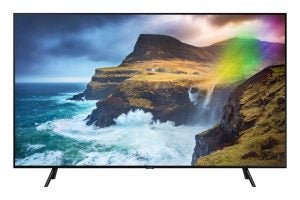
The Check TV Space feature automatically adjusts the sonic characteristics of the TV based on your environment, optimising the overall performance. The Adaptive Sound feature also offers the choice of Standard or Amplify, with the latter intended for noisier environments. The Adaptive Volume is effective at automatically adjusting the volume depending on normal usage and the time of day. The result is a sonic all-rounder that sounds surprisingly good with TV shows, movies, and games.
The AI processing enhances any content by ensuring dialogue is clear, music more defined, effects more precise, and crowd noises more enveloping. The Q70 doesn’t support Dolby Atmos processing, but Samsung has finally made its TVs capable of sending Dolby Atmos from the internal apps such as Netflix and Amazon to supporting soundbars and AV receivers via the HDMI-ARC. This is arguably more useful than internally processing Atmos with only a pair of speakers.
If you feel like boosting the audio on your Q70 then there are numerous soundbar options available, although the obvious choice would be the similarly monikered Samsung HW-Q70R. This model is styled to match the Q70 and includes a wireless subwoofer and support for Dolby Atmos and DTS:X.
Related: Best Soundbars
Should I buy the Samsung QE55Q70R?
The Samsung QE55Q70R offers the cheapest way of enjoying the full benefits of the company’s QLED range, including direct backlighting, local dimming, and quantum dot technology. However, Samsung has cut a few corners to reach the lower price point, so wider viewing angles, an ultra-black filter and One Connect box are lacking. The Q70 also isn’t as bright as the pricier models – but in all other respects you get the full QLED experience.
What that means is that the 4K picture is detailed and accurate, with plenty of pop thanks to a bright picture and saturated colours. The direct backlight and local dimming ensure deep blacks and excellent contrast. The AI-enhanced processing is cutting-edge, squeezing the best out of whatever content you display, while the HDR performance is impressive. Uniformity is good and the screen handles reflections well, but the optimal viewing angles are limited.
Picture quality aside, the Q70 also includes all the features found further up the line, such as Adaptive Sound, built-in Bixby, and a 14ms input lag. The smart system is fast, responsive and intuitive to use, with a comprehensive selection of video streaming services that now exclusively includes Apple TV. As a result, the Samsung QE55Q70R is a great all-rounder that’s competitively priced for a mid-range model, making it worthy of recommendation.
If you’re looking for alternatives to the Samsung Q70, the Sony KD-55XG9505 is worth considering. It costs a bit more at £1499 but includes full array local dimming, a Triluminos display, X-Wide Angle viewing, X-Motion Clarity, and the X1 Ultimate processor. There’s no support for HDR10+, but you do get Dolby Vision and Atmos, along with the Android smart platform and built-in Google Assistant.
The LG 55SM90 is priced at £1399, which puts it in direct competition to the Q70. This LG model boasts full array local dimming, NanoCell technology for better colours and deeper blacks, wider viewing angles thanks to an IPS panel, and the second generation Alpha7 processor. LG doesn’t support HDR10+ either, but you do get Dolby Vision and Atmos, along with webOS 4.5, Google Assistant and Amazon Alexa built-in, and a very low input lag.
How we test televisions
We test every TV we review thoroughly over an extended period of time. We use industry standard tests to compare features properly. We’ll always tell you what we find. We never, ever, accept money to review a product.


